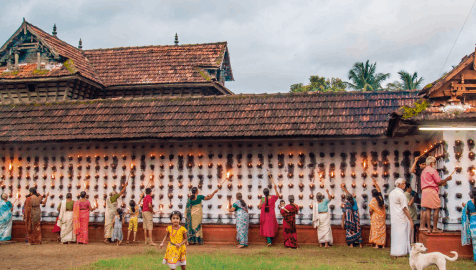
From Origin to Uppar Junction in TN
Exact Point of Origin could not be ascertained from Google Earth. The origin is somewhere on the higher ranges in the Anamalai Tiger Reserve where the most prominent peak that could be judged from the satellite imageries is at an elevation of about 2100 m.
Uppar Jn to Kerala Border
Thus the total length of the Main River in Tamil Nadu is 68.45 Kms. Coconut plantations abound on either banks of the River between Uppar Jn and Kerala with minimal constructions close to the River.
Chittur Puzha – From TN Border to Parali Sangamam
Parali Jn with Kalapathy Puzha – 116 Km. With 16 Weirs in less than 48 Kms of Length, the river section averages with one weir every 3 Km of length. However, most Weirs are seen made indiscriminately with the last 7 Weirs made in 11.4 Kms’ length, a set of another 3 in just 1.4 Km and the first two at just 600 meters’apart!
Bharatappuzha - Parali Sangamam to Ponnani Azhimukham
Total Length : 90.97 Km. Grand Total – Length of Bharathappuzha from the Origin in Tmail Nadu to Ponnani Azhimukham is : 206.97 Km This is seen 2 Km less than the 209 Km that is reported in the recent papers by various agencies.
Bharathapuzha has five major tributaries namely Chittoorpuzha, Kalpathipuzha, Gayatripuzha, Thoothapuzha and Tirurpuzha. The Palar, Uppar and Aliyar are subtributaries of the Coimbatore district where the Chittoor Puzha originates. The Korayar, Varattar, Walayar and Malampuzha are the tributaries of the Kalpathipuzha and the Pothundi, Meenkara, Chulliyar and Mangalam puzha are the subtributaries of the Gayatri Puzha. All these originate from different parts of the Western Ghats and flow westwards into the Bharathapuzha.
The Chittoor Puzha, a major tributary of the Bharathapuzha, joins the Kalpathipuzha near the Parali Bridge. The river then flows west through the Bharatha Ghanda and joins with the Gayatripuzha, at “Mayanur”.Thoothupuzha merges with Bharathapuzha at Koodalloor”Kuttakkadavu” near Trithala. Thirur Puzha, the last and fifth tributary joins the Bharathapuzha at Ponnani, which then joins the Arabian Sea.
Bharathapuzha, which is not a perennial river. It is rich in water only during monsoons. Due to the high hydraulic gradient of the river, the amount of rainwater released into the river will reach the Arabian Sea within 48 hours. For water storage, there are Trimurti, Aliyar, Walayar, Malampuzha, Pothundi, Mangalam, Chulliyar and Meenkara dams in Bharathapuzha and regulators at Moolathara, Velliyankallu and Chamravattam.
There are several check dams like:
Kalpathi
Njavalin Kadavu
Lakkidi
Thrangali
Shornoor
Changanakkunnu
Koottukadavu

The father of the Malayalam language, Thunchath Ramanujan Ezhuthachan and the Gnyanapeeth winner who nurtured Malayalam, M. T. Vasudevan Nair, the great poet Akkitham, M. P. Shankunni Nair, P. Kunjiraman Nair, V. T Bhattathiripad, Punnassery Neelakanda Sharma, K. P. Narayana Pisharody, V. K. N., Kunchan Nambiar, Vilvamangalam, Melpathur, Vallathol, C. Radhakrishnan, O.V. Vijayan, Olappamanna and Alancode Leela Krishnan all grew up on this river bank.

Festivals known as ‘Velapurams’ are another major celebrations on the bank of this river. ‘Aana-poorams’, ‘Aanayilla-poorams’, Kaalaveela, ‘poothan’, ‘thira’, ‘thattinmelkoothu’, ‘tholppavakoothu’ and ‘devaratha prayanam’ all add to the festivities along the Bharathapuzha-bank . Fireworks, orchestras and performances of traditional art forms are part of the festivities.Koothu, Koodiyattam, Thullal and Kathakali are also performed here as part of the festivities and rituals.
This river bank is rich with legends. Bharathapuzhayoram is the birthplace of the Parayipetta Panthirukulam, one of the most beautiful myths of Kerala. All the 10 people out of 12 is the Panthirukula story are from Bharathapuzha bank . Many of their descendants still live on this riverbank. There are legendary monuments associated with them along the river. If you walk along the river with a mind that loves stories, we will experience their presence.
